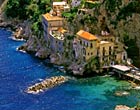Italy: Beautiful, Unspoiled Paestum, Remnant of Magna Grecia
THE ANNOTIC REPORT
We must never forget that while there
was an "area" of Greece, there was NO country of Greece, it was merely
an area of warring City -States. In each of those City States there were
such rigid, suffocating, stultifying society, that the most creative people
left Minor Greece area to settle in Colonies in Southern Italy and Sicily.
The resulting Magna Grecia (Greater Greece) is where Culture, Philosophy,
Science, blossomed to such an extent that completely out shown Grecia Minor,
which is not readily known, and something that Greece is slow to admit
to, and Italy is slow to embrace. Greeks starting to arrive in 8 BC, were
entirely Italianized by 4 BC
http://en.wikipedia.org/wiki/Magna_Graecia
Famous Italian/Magna Grecians included:
Pythagoras (Pythagorean Theory, but Founder of a Philosophy School in Sicily).
Archemedes (born and died in Syracuse).Herodotus, the Sophist Protagoras,
the architect Hippodamus. Ulysses, Ajax, Philoctetes, Meneleos, Epeius
(the builder of the Trojan horse), Heracles and many others.
http://marcheo.napolibeniculturali.it/itinerari-tematici/in-museum/T_RA7
Magna Grecia was Considered Greece's "America", Land of Opportunity: http://www.calabria.nu/magna.htm
Yet, Magna Grecia become indifferent to the fate of its' mother country. When Darius invaded Greece, Democedes sent only one trireme to fight against the Persians.
Italy: Beautiful, Unspoiled Paestum
On the wide plain that edges the Gulf of Salerno, the ruins of three ancient civilizations -- Greek, Lucan and Roman -- intrigue modern-day visitors. Among the treasures: three breathtaking temples.
Los Angeles Times
By Susan Spano
Reporting from Paestum, Italy
May 08, 2009
 Even
if there were no fresh mozzarella cheese on the wide plain that edges the
Gulf of Salerno in southern Campania, the Greek ruins of Paestum would
be reason enough for coming here.
Even
if there were no fresh mozzarella cheese on the wide plain that edges the
Gulf of Salerno in southern Campania, the Greek ruins of Paestum would
be reason enough for coming here.
Paestum was settled around 600 BC as part of a wave of Greek expansion that created a chain of colonies, known as Magna Graecia, around the Mediterranean basin. Now it's one of the most intriguing archaeological sites in Italy, visible proof of the subsequent Roman Empire's classical Hellenic foundations. It's still unspoiled enough to make modern-day visitors feel like discoverers.
Paestum's three huge, elegant, breathtaking Doric-columned Greek temples loom above the plain about five miles south of the beach town of Capaccio. The modest entrance across the lane from the museum yields to a greensward covered with dandelions and clover, where dogs and visitors roam freely.
Sightseers get scant explanation, so it's best to buy a guidebook at one of the shops by the entrance to find less obvious features such as the large house with a marble pool, or impluvium, for collecting rainwater and the Roman-era amphitheater.
The Greeks who founded Paestum succumbed to the inland Lucan people, who left marvelously frescoed tombs in the area, and then to the Romans in the 3rd century BC. After the fall of the Roman Empire, Paestum was all but abandoned to the malaria-infested marshes.
It wasn't until the 18th century, when Pompeii and Herculaneum were rediscovered, that Grand Tour travelers stumbled upon the ruins of Paestum, as perfect and undisturbed as Sleeping Beauty.
The nearby museum has a rich cache of findings from the Paestum area, including a collection of Lucanian tomb slabs bearing brightly painted images that look almost like doodles. Most famous among them is a fresco of a diver caught in midair, symbolizing the soul's plunge from this life to the next.
Take time to study the museum's series of metopes, or stone panels decorating the frieze above a row of Doric columns. They were found at the site of an important Greek temple, dedicated to Hera, at the mouth of the Sele River about 10 miles north of Paestum. With almost comic book vividness, the metopes depict mythological scenes, including Hercules' capture of the dwarfish Cercopes, tied by their feet to a pole hoisted on the hero's shoulders.
No standing ruins remain at the site of the Hera sanctuary, but the Museum of Hera Agriva Sanctuary has excellent multimedia exhibits on the cult of Hera and the work of Paola Montuoro and Umberto Bianco, Italian archaeologists who discovered the sanctuary in 1934.
The old stones of Foce Sele lie scattered near the river, surrounded by artichoke fields and pastures where water buffaloes graze -- a magical Italian landscape in which daily life goes on amid the ruins of an ancient civilization. susan.spano@latimes.com
http://travel.latimes.com/articles/la-trw-mozzarellapaestumside10-2009may10
The ANNOTICO Reports Can be
Viewed (With Archives) on:
![]() [Formerly
Italy at St Louis]
[Formerly
Italy at St Louis]